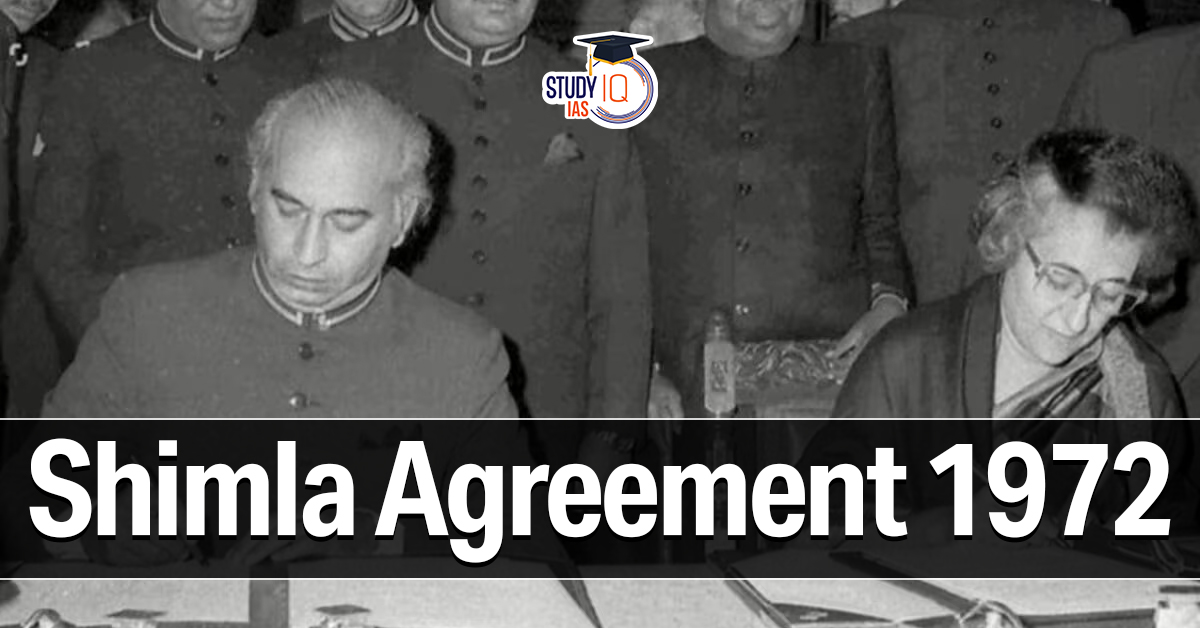Table of Contents
The Shimla Agreement of 1972 is one of the landmark peace accords in the history of India-Pakistan relations. Signed between India and Pakistan after the 1971 India-Pakistan War, it sought to bring lasting peace and stability to the South Asian subcontinent. This article delves into the details of the Shimla Agreement, its significance, key provisions, and its impact on India-Pakistan relations.
Shimla Agreement Suspended
The 1972 Shimla Agreement, long seen as the bedrock of peaceful bilateral ties between India and Pakistan, has been suspended by Pakistan after the Pahalgam terror attack on April 22, 2025, that left 26 dead. In retaliation, Pakistan shut its airspace to Indian airlines, suspended trade and visas, and warned that diverting Indus waters would be an ‘act of war.’
India responded by suspending the Indus Waters Treaty, expelling diplomats, and sealing borders. With troops exchanging fire along the LoC, the move marks a dangerous shift, threatening regional peace and bilateral conflict resolution mechanisms.
What is the Shimla Agreement?
The Shimla Agreement was signed on July 2, 1972, in the Indian hill town of Shimla (Himachal Pradesh) between Indian Prime Minister Indira Gandhi and Pakistan’s President Zulfikar Ali Bhutto. This peace treaty was a significant step in India-Pakistan diplomacy, concluding the 1971 Indo-Pak war that had resulted in the creation of Bangladesh. The agreement aimed to normalise relations between the two countries and establish a peaceful framework for resolving their bilateral disputes.
Key Background Events
-
1971 Indo-Pakistan War: The war culminated in a decisive victory for India, leading to the independence of Bangladesh (formerly East Pakistan). The war also left Pakistan humiliated, with a large number of Pakistani soldiers surrendering in Dhaka.
-
Bangladesh’s Liberation: Following the war, India played a crucial role in Bangladesh’s independence, a point that was recognized in the Shimla Agreement when Pakistan agreed to formally acknowledge Bangladesh as a sovereign nation.
Main Objectives of the Shimla Agreement
The Shimla Agreement aimed to build a new era of peace, cooperation, and stability between India and Pakistan. The key objectives of the agreement were as follows:
Bilateral Dialogue and Peaceful Resolution of Disputes
The agreement emphasised that all disputes between the two countries, especially the Kashmir dispute, should be settled bilaterally without third-party involvement, such as the United Nations.
Recognition of Sovereignty and Territorial Integrity
-
Pakistan’s Recognition of Bangladesh: One of the significant outcomes of the agreement was Pakistan’s formal recognition of Bangladesh as an independent and sovereign nation.
-
Mutual Respect for Borders: Both nations pledged to respect each other’s territorial integrity and sovereignty. This meant a commitment to no unilateral changes in borders or territories, including the Line of Control (LoC) in Jammu and Kashmir.
Establishment of the Line of Control (LoC)
-
The agreement renamed the Ceasefire Line in Kashmir to the Line of Control (LoC), a crucial step in making the Kashmir issue a bilateral matter rather than an international one, sidestepping UN involvement.
-
Both countries agreed to respect the LoC and refrain from any military action that would alter the border.
Settlement of Prisoners of War and Civilian Hostages
-
The agreement set out the release of prisoners of war and civilians who had been captured during the 1971 war, ensuring a process for humanitarian repatriation.
Significance of the Shimla Agreement
The Shimla Accord remains one of the most important diplomatic milestones in South Asia. Its significance can be understood through the following points:
Shift to Bilateralism
-
The Shimla Agreement shifted the Kashmir issue from an international forum to a bilateral discussion between India and Pakistan. This was a critical move because it meant that both nations were directly responsible for resolving the issue without external interference.
Strategic Importance of the LoC
-
The agreement formalised the LoC, making it the de facto border between India and Pakistan in Jammu and Kashmir. This decision was pivotal in reducing international pressure on the region and increasing both countries’ ownership of the dispute.
Normalization of Diplomatic Relations
-
The agreement led to the resumption of diplomatic relations between the two countries and established channels for communication, reducing the likelihood of misunderstandings and military confrontations.
Pakistan’s Acknowledgement of Bangladesh
-
The Shimla Agreement required Pakistan to recognise Bangladesh’s independence, marking a historic shift in the region’s geopolitics. This was crucial in ensuring long-term peace between the nations, as it removed a lingering source of hostility.
Key Provisions of the Shimla Agreement
The following are the core provisions of the Shimla Agreement:
-
Ceasefire Line Renamed to Line of Control:
-
India and Pakistan agreed to rename the ceasefire line as the Line of Control (LoC) and agreed that it would be respected by both sides.
-
-
Respect for Each Other’s Sovereignty:
-
Both countries agreed to refrain from the use of force or threats of force and committed to maintaining peace through dialogue.
-
-
Bilateral Negotiation for Dispute Resolution:
-
The agreement stipulated that both countries should settle their disputes bilaterally and peacefully, in line with the principle of territorial integrity and sovereign equality.
-
-
Return of Prisoners of War:
-
The agreement ensured the return of prisoners of war and civilians detained during the conflict, facilitating a humanitarian gesture between the two countries.
-
Impact of the Shimla Agreement
The Shimla Agreement has had both positive and negative consequences in the India-Pakistan relationship:
Positive Impact
-
De-escalation of tensions: The agreement played a significant role in preventing an escalation of conflict following the 1971 war.
-
Improved Diplomatic Ties: Both countries reopened diplomatic channels and engaged in subsequent rounds of talks, although some issues remained unresolved.
Negative Impact
-
Failure to Resolve Kashmir Issue: While the Shimla Agreement moved Kashmir to a bilateral framework, the Kashmir dispute remains unsolved to this day, with several military skirmishes and ceasefire violations occurring over the years.
-
Terrorism and Cross-Border Conflicts: Despite the treaty, cross-border terrorism has remained a major point of conflict, particularly after the 1999 Kargil War and multiple terror attacks linked to Pakistan-based militants.
Shimla Agreement Today: Relevance in Modern Geopolitics
While the Shimla Agreement has not fully resolved all the issues between India and Pakistan, it remains a vital diplomatic framework that both countries refer to when managing their relations. The LoC continues to be a volatile border, but the Shimla Accord laid the groundwork for future peace talks.
Pakistan’s Recent Move
Pakistan’s recent suspension of the Shimla Agreement marks a turning point in India-Pakistan relations. The move could reignite tensions along the LoC and place international pressure back on the Kashmir issue.
Conclusion
The Shimla Agreement of 1972 remains a cornerstone of India-Pakistan relations, symbolizing both hope for peace and the challenges of reconciliation. While it has helped reduce the intensity of hostilities between the two nations, its unresolved issues continue to loom large over the region. Understanding its provisions, impact, and ongoing relevance is crucial for anyone studying South Asian geopolitics, conflict resolution, and international diplomacy.


 China's Salami Slicing Tactics
China's Salami Slicing Tactics
 United States Federal Reserve (US Fed)
United States Federal Reserve (US Fed)
 EU Naval Force Operation Atlanta propose...
EU Naval Force Operation Atlanta propose...





















